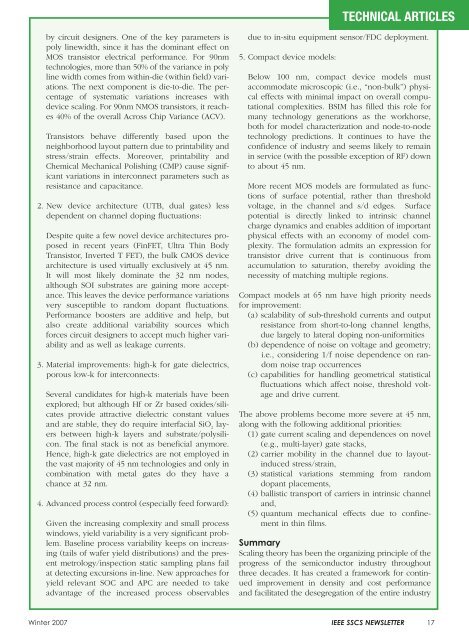The Impact of Dennard's Scaling Theory - IEEE
The Impact of Dennard's Scaling Theory - IEEE
The Impact of Dennard's Scaling Theory - IEEE
- TAGS
- scaling
- www.ieee.org
You also want an ePaper? Increase the reach of your titles
YUMPU automatically turns print PDFs into web optimized ePapers that Google loves.
y circuit designers. One <strong>of</strong> the key parameters is<br />
poly linewidth, since it has the dominant effect on<br />
MOS transistor electrical performance. For 90nm<br />
technologies, more than 50% <strong>of</strong> the variance in poly<br />
line width comes from within-die (within field) variations.<br />
<strong>The</strong> next component is die-to-die. <strong>The</strong> percentage<br />
<strong>of</strong> systematic variations increases with<br />
device scaling. For 90nm NMOS transistors, it reaches<br />
40% <strong>of</strong> the overall Across Chip Variance (ACV).<br />
Transistors behave differently based upon the<br />
neighborhood layout pattern due to printability and<br />
stress/strain effects. Moreover, printability and<br />
Chemical Mechanical Polishing (CMP) cause significant<br />
variations in interconnect parameters such as<br />
resistance and capacitance.<br />
2. New device architecture (UTB, dual gates) less<br />
dependent on channel doping fluctuations:<br />
Despite quite a few novel device architectures proposed<br />
in recent years (FinFET, Ultra Thin Body<br />
Transistor, Inverted T FET), the bulk CMOS device<br />
architecture is used virtually exclusively at 45 nm.<br />
It will most likely dominate the 32 nm nodes,<br />
although SOI substrates are gaining more acceptance.<br />
This leaves the device performance variations<br />
very susceptible to random dopant fluctuations.<br />
Performance boosters are additive and help, but<br />
also create additional variability sources which<br />
forces circuit designers to accept much higher variability<br />
and as well as leakage currents.<br />
3. Material improvements: high-k for gate dielectrics,<br />
porous low-k for interconnects:<br />
Several candidates for high-k materials have been<br />
explored; but although Hf or Zr based oxides/silicates<br />
provide attractive dielectric constant values<br />
and are stable, they do require interfacial SiO 2 layers<br />
between high-k layers and substrate/polysilicon.<br />
<strong>The</strong> final stack is not as beneficial anymore.<br />
Hence, high-k gate dielectrics are not employed in<br />
the vast majority <strong>of</strong> 45 nm technologies and only in<br />
combination with metal gates do they have a<br />
chance at 32 nm.<br />
4. Advanced process control (especially feed forward):<br />
Given the increasing complexity and small process<br />
windows, yield variability is a very significant problem.<br />
Baseline process variability keeps on increasing<br />
(tails <strong>of</strong> wafer yield distributions) and the present<br />
metrology/inspection static sampling plans fail<br />
at detecting excursions in-line. New approaches for<br />
yield relevant SOC and APC are needed to take<br />
advantage <strong>of</strong> the increased process observables<br />
TECHNICAL ARTICLES<br />
due to in-situ equipment sensor/FDC deployment.<br />
5. Compact device models:<br />
Below 100 nm, compact device models must<br />
accommodate microscopic (i.e., “non-bulk”) physical<br />
effects with minimal impact on overall computational<br />
complexities. BSIM has filled this role for<br />
many technology generations as the workhorse,<br />
both for model characterization and node-to-node<br />
technology predictions. It continues to have the<br />
confidence <strong>of</strong> industry and seems likely to remain<br />
in service (with the possible exception <strong>of</strong> RF) down<br />
to about 45 nm.<br />
More recent MOS models are formulated as functions<br />
<strong>of</strong> surface potential, rather than threshold<br />
voltage, in the channel and s/d edges. Surface<br />
potential is directly linked to intrinsic channel<br />
charge dynamics and enables addition <strong>of</strong> important<br />
physical effects with an economy <strong>of</strong> model complexity.<br />
<strong>The</strong> formulation admits an expression for<br />
transistor drive current that is continuous from<br />
accumulation to saturation, thereby avoiding the<br />
necessity <strong>of</strong> matching multiple regions.<br />
Compact models at 65 nm have high priority needs<br />
for improvement:<br />
(a) scalability <strong>of</strong> sub-threshold currents and output<br />
resistance from short-to-long channel lengths,<br />
due largely to lateral doping non-uniformities<br />
(b) dependence <strong>of</strong> noise on voltage and geometry;<br />
i.e., considering 1/f noise dependence on random<br />
noise trap occurrences<br />
(c) capabilities for handling geometrical statistical<br />
fluctuations which affect noise, threshold voltage<br />
and drive current.<br />
<strong>The</strong> above problems become more severe at 45 nm,<br />
along with the following additional priorities:<br />
(1) gate current scaling and dependences on novel<br />
(e.g., multi-layer) gate stacks,<br />
(2) carrier mobility in the channel due to layoutinduced<br />
stress/strain,<br />
(3) statistical variations stemming from random<br />
dopant placements,<br />
(4) ballistic transport <strong>of</strong> carriers in intrinsic channel<br />
and,<br />
(5) quantum mechanical effects due to confinement<br />
in thin films.<br />
Summary<br />
<strong>Scaling</strong> theory has been the organizing principle <strong>of</strong> the<br />
progress <strong>of</strong> the semiconductor industry throughout<br />
three decades. It has created a framework for continued<br />
improvement in density and cost performance<br />
and facilitated the desegregation <strong>of</strong> the entire industry<br />
Winter 2007 <strong>IEEE</strong> SSCS NEWSLETTER 17




